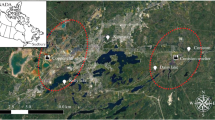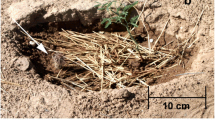Abstract
The Hole-in-the-Donut is a 4000-ha region of former farmlands within Everglades National Park that is dominated by a monoculture of the non-indigenous pest plantSchinus terebinthifolius (Brazilian pepper). Prior to extensive farming in the region, the area consisted of short hydroperiod graminoid wetlands and mesic pine savannah. Rock plowing in preparation of these lands for farming created an artificial soil layer that broke up the limestone substrate, mixed and aerated the native marl soil layer with the broken limestone, and elevated the surface slightly. Farming practices also included the use of chemical fertilizers and pesticides. The modified soil substrate quickly became dominated byS. terebinthifolius when farming ceased in 1975, despite efforts to control its establishment, such as prescribed fire, herbicide treatment, and mowing. Preliminary evidence indicated that soil removal would prevent re-invasion byS. terebinthifolius and could lead to colonization by native wetlands plants. Two trials, a partial soil removal (PSR) and a compete soil removal (CSR), were performed on a pilot test site beginning in 1989 to determine whether all or only a portion of this modified soil substrate needed to be removed to attain desired results. Removal of rock-plowed surface material lowered elevation in both treatments. While the PSR treatment did show an increase in the number and coverage of hydrophytes for a few years, it did not prohibit re-colonization and re-establishment of a canopy ofS. terebinthifolius, and by 1996, the site was again dominated by a monoculture ofS. terebinthifolius. By contrast, the CSR treatment showed rapid colonization by hydrophytes and no successful re-colonization byS. terebinthifolius. Lowering elevations by 15 to 45 cm allowed for longer periods of flooding and rapid colonization by hydrophytes on both sites. After the sites were cleared, the average difference in elevation between the two treatment areas was less than a tenth of a meter, but this resulted in a slightly shorter hydroperiod on the PSR site. The small amount of residual rock-plowed soil with high levels of nutrients, along with its slightly shorter hydroperiod on the PSR site, appear to have contributed significantly to the success ofS. terebinthifolius in re-colonizing this treatment area.
Similar content being viewed by others
Literature Cited
Armentano, T. V., R. F. Doren, W. J. Platt, and T. Mullins. 1995. Effects of Hurricane Andrew on coastal and interior forests of southern Florida: overview and synthesis. Journal of Coastal Research 21:111–144.
Bazzaz, F. A. 1996. Plants in Changing Environments. Gambridge University Press, Cambridge, UK.
Briske, D. D. and J. D. Derner. 1998. Clonal biology of caespitose grasses. p. 106–135.In G. P. Cheplick (ed.) Population Biology of Grasses. Cambridge University Press, Cambridge, UK.
Colinvaux, P. 1986. Ecology. John Wiley and Sons, New York, NY, USA.
Correll, D. S. and H. B. Correll. 1982. Flora of the Bahama Archipelago. Lubrecht Cramer Limited, Port Jervis, NY, USA.
Dalrymple, N. K., G. H. Dalrymple, and K. A. Fanning. 1993. On the vegetation of restored and unrestored rock-plowed wetlands of the East Everglades of southern Florida. Restoration Ecology 1:220–225.
Derner, J. D., D. D. Briske, and T. W. Boutton. 1997. Does grazing mediate soil carbon and nitrogen accumulation beneath C4 perennial grasses along an environmental gradient? Plant and Soil 191: 147–156.
Doren, R. F. and L. D. Whiteaker. 1988. Proposal for mitigation and monitoring of secondary successional communities in ENP: Hole-in-the-Donut. Everglades National Park. Homestead, FL, USA.
Doren, R. F. and L. D. Whiteaker 1990a. Comparison of economic feasibility of chemical control strategies on differing age and density classes ofSchinus terebinthifolius. Natural Areas Journal 10: 28–34.
Doren, R. F. and L. D. Whiteaker. 1990b. Effects of fire on different size individuals ofSchinus terebinthifolius. Natural Areas Journal 10:106–113.
Doren, R. F., L. D. Whiteaker, G. Molnar, and D. Sylvia. 1990. Restoration of former wetlands within the Hole-in-the-Donut in ENP. p. 33–50.In F. J. Webb, Jr. (ed.) Proceedings of the Seventh Annual Conference on Wetland Restorations and Creation. Hillsborough Community College, Plant City, FL, USA.
Ewel, J. J. 1986. Invasibility: lessons from south Florida. p. 214–230.In A. H. Mooney and J. J. Drake (eds.) Ecology of Biological Invasions of North America and Hawaii. Springer Verlag, New York, NY, USA.
Ewel, J. J., D. S. Ojima, D. A. Karl, and W. F. Debusk. 1982.Schinus in successional ecosystems of Everglades National Park. South Florida Research Center, Everglades National Park, Homestead, FL, USA. Technical Report T-676.
Gauch, H. G., Jr. 1982. Multivariate Analysis in Community Ecology. Cambridge University Press, New York, NY, USA.
Godfrey, R. K. and J. W. Wooten. 1981. Aquatic and Wetland Plants of Southeastern United States: Dicotyledons. University of Georgia Press, Athens, GA, USA.
Gross, K. L. 1987. Mechanisms of colonization and species persistence in plant communities. p. 173–188.In W. R. Jordan, M. E. Gilpin, and J. D. Aber (eds.) Restoration Ecology: a Synthetic Approach to Ecological Research. Cambridge University Press, Cambridge, U K.
Kent, M. and P. Coker. 1994. Vegetational Description and Analysis. Wiley and Sons, New York, NY, USA.
Krauss, P. 1987. Old field succession in Everglades National Park. South Florida Research Center Report, Everglades National Park, Homestead, FL, USA. Technical Report SFRC-87/03.
Li, Y. and M. Norland. 2001. The role of soil fertility in invasion of Brazilian pepper (Schinus terebinthifolius) in Everglades National Park, Florida. Soil Science 166:400–405.
Long, W. L. and O. Lakela. 1971. A Flora of Tropical Florida. University of Miami Press, Coral Gables, FL, USA.
Loope, L. L. and V. L. Dunevitz. 1981. Investigations of early plant succession on abandoned farmland in Everglades National Park. South Florida Research Center, Everglades National Park, Homestead, FL, USA. Fechnical Report T-644.
MacArthur, R. M. and E. O. Wilson. 1967. The Theory of Island Biogeography. Princeton University Press. Princeton, NJ, USA.
Mueller-Dombois, D. and H. Ellenberg. 1974. Aims and Methods of Vegetation Ecology. John Wiley and Sons, Inc, New York, NY, USA.
Olmsted, I. and L. L. Loope. 1984. Plant communities in Everglades National Park. p. 167–184.In P. J. Gleason (ed.) Environments of South Florida Present and Past II. Miami Geological Society, Miami, FL, USA.
Orth, P. G. 1981. Fertility management of Dade County soils. Soil Crop Science Society Florida Proceedings 40:1–3.
Orth, P. G. and R. A. Conover. 1975. Changes in nutrients resulting from farming the Hole-in-the-Donut, Everglades National Park. Proceedings of Florida State Horticultural Society 28:221–225.
Pielou, E. C. 1984. The Interpretation of Ecological Data. John Wiley and Sons, New York, NY, USA.
Reed, P. B., Jr. 1988. National List of Plant Species That Occur in Wetlands: Southeast Region (Region 2). National Wetlands Inventory, U.S. Fish and Wildlife Service, Washington, DC, USA. Biological Report 88(26.2).
Sokal, R. R. and F. J. Rohlf. 1995. Biometry. W. H. Freeman, New York, NY, USA.
StatSoft. 1994. Statistica for Windows. StatSoft, Inc. Tulsa, OK. USA.
Steward, K. K. and W. H. Ornes. 1975. The autecology of sawgrass in the Florida Everglades. Ecology 56:162–171.
Tilman, D. 1988. Plant Strategies and the Dynamics and Structure of Plant Communities. Princeton University Press, Princeton, NJ, USA.
Whittaker, R. H. 1975. Communities and Ecosystems, second edition. MacMillan, New York, NY, USA.
Wunderlin, R. P. 1998. Guide to the Vascular Plants of Florida. University Press of Florida, Gainesville, FL, USA.
Zar, J. H. 1996. Biostatistical Analysis, third edition. Prentice-Hall, Englewood Cliffs, NJ, USA.
Author information
Authors and Affiliations
Rights and permissions
About this article
Cite this article
Dalrymple, G.H., Doren, R.F., O'Hare, N.K. et al. Plant colonization after complete and partial removal of disturbed soils for wetland restoration of former agricultural fields in Everglades National Park. Wetlands 23, 1015–1029 (2003). https://doi.org/10.1672/0277-5212(2003)023[1015:PCACAP]2.0.CO;2
Received:
Revised:
Accepted:
Issue Date:
DOI: https://doi.org/10.1672/0277-5212(2003)023[1015:PCACAP]2.0.CO;2




